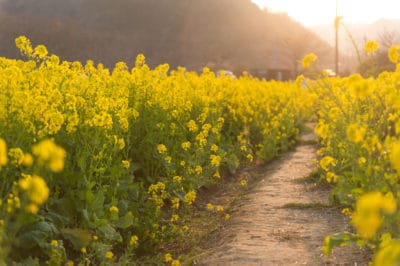Mustard Flower
One of the best ways to identify a mustard plant is through the flower. Whether yellow or white, if it has four petals and six stamens you know it is a mustard. The name ‘cruciferous’ refers to this plant family’s four-petaled flowers which form a cross.
The six stamens are arranged in an ‘H’ like shape with four long and two short. There is a pistil that appears as a fuzzy staff upright in the middle of the flower.
Sinapis Alba
The seed of any mustard plant can be crushed and combined with vinegar and spices to make the familiar condiment by the same name. Different varieties of mustard create slightly different tasting spreads.
Sinapis alba is yellow or white mustard. The color refers to the seeds which are pitted and yellow or white. This Mediterranean native is where most of the condiment mustard comes from. This plant grows to about 3 feet in height, displays scattered branches and has irregular lobed leaves. The yellow flowers have four petals and the seedpods are tapered and bristly. The best ways to identify a member of the mustard family are:
- Yellow or White flowers
- Flowers have 4 petals in cross shape
- 6 Stamens in H shape
- Seed pods are tapered
- Seeds are round 1-2mm diameter
Brassica Juncea
Native to Asia, this is commonly called brown mustard, chinese mustard, canola, or leaf mustard. This is a common variety grown in Russia and Asia not only as a spice but as a source of cooking oil and greens. The seeds of certain varieties of Brassica juncea are crushed to produce canola oil.
Some mustard green cultivars we are familiar with belong to the Juncea genera such as Mizuna, Crispafolia, and Takana. The flowers of juncea are yellow and similar to other varieties. The leaves, however, are varying.
Mizuna produces highly frilled and textured greens often picked young to add texture to salads. Crispafolia, on the other hand, has smooth leaves that are broad and thick. Brown mustard seed pods contain up to 20 seeds compared to Sinapis alba which contains roughly 6.
Brassica Nigra
This type of mustard is native to most of Africa and parts of India and Asia. While not cultivated as much as the other varieties, it is still a highly prized crop. The seeds of nigra are dark brown to black. They are also used as a spice, most often found in curries and as accents in gourmet mustards.
Traditionally the seed was also crushed to produce an oil used for cooking, and the leaves are eaten as a green. The nigra also has yellow four-petaled flowers. The plant is lankier than the other varieties and the leaves are smooth but toothed.
